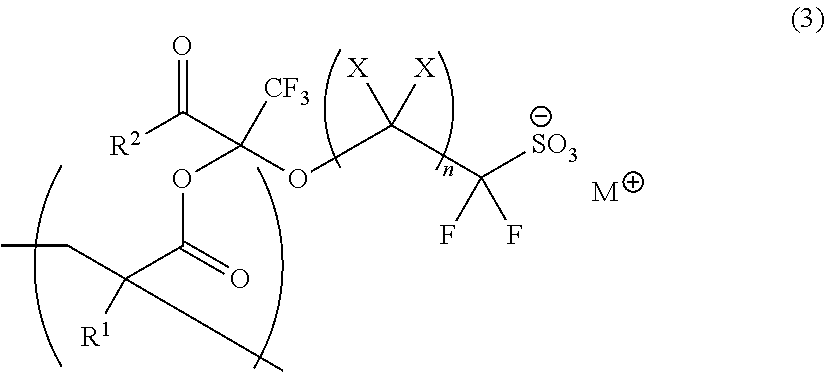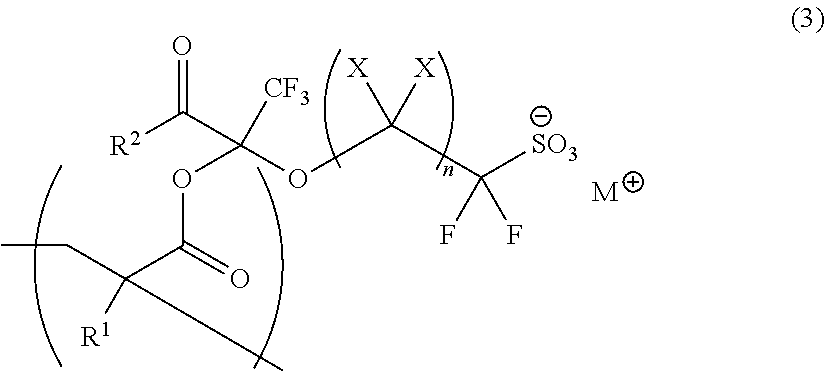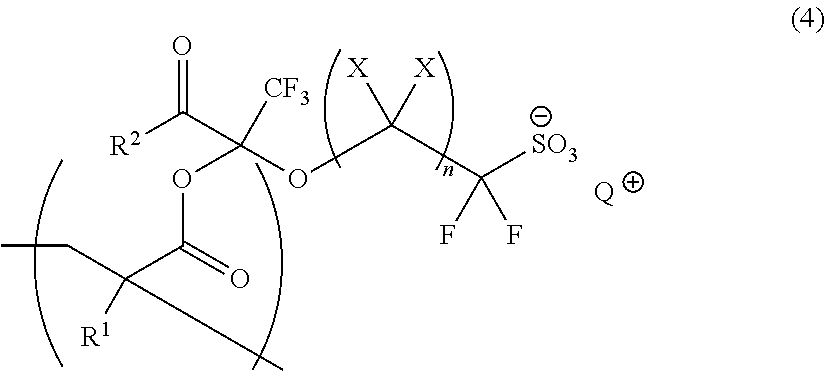Polymerizable Fluorine-Containing Sulfonate, Fluorine-Containing Sulfonate Resin, Resist Composition And Pattern-Forming Method Using Same
- Summary
- Abstract
- Description
- Claims
- Application Information
AI Technical Summary
Benefits of technology
Problems solved by technology
Method used
Image
Examples
synthesis example 1
Triphenylsulfonium 2-(1-Ethoxycarbonyl-1-methacryloyloxy-2,2,2-trifluoroethoxy)-1,1-difluoroethanesulfonat e
[0275]
[0276]First, 5.0 g of triphenylsulfonium 2-hydroxy-1,1-difluoroethanesulfonate in white solid form (purity: 62.2%; equivalent to 7.3 mmol) was dissolved by stirring into 35 g of chloroform. The resulting solution was admixed with 1.46 g (8.55 mmol) of ethyltrifluoromethyl pyruvate and subjected to reaction for 3 hours at room temperature. The reaction solution was then concentrated under a reduced pressure. To the concentrated solution, 26.5 g of acetonitrile was added to dissolve the reaction intermediate by stirring.
[0277]The dissolved solution was admixed with 1.47 g (9.54 mmol) of methacrylic acid anhydride, 1.06 g (10.47 mmol) of triethylamine and 0.02 g (0.16 mmol) of 4-dimethylaminopyridine as a catalyst. The resulting mixture was stirred for 4 hours at 20 to 30° C. The organic layer was then separated with the addition of 30 g of chloroform and 50 g of ion-exchan...
synthesis example 2
Triphenylsulfonium 4-(1-Ethoxycarbonyl-1-methacryloyloxy-2,2,2-trifluoroethoxy)-1,1,2,2-tetrafluorobutanesu lfonate
[0281]
[0282]First, 14.4 g of triphenylsulfonium 4-hydroxy-1,1,2,2-tetrafluorobutanesulfonate in viscous liquid form (purity: 80%; equivalent to 23.6 mmol) was dissolved by stirring into 60 g of chloroform. The resulting solution was admixed with 7.5 g (43.8 mmol) of ethyltrifluoromethyl pyruvate and subjected to reaction for 3 hours at room temperature. The reaction solution was then concentrated under a reduced pressure. To the concentrated solution, 40 g of acetonitrile was added to dissolve the reaction intermediate by stirring.
[0283]The dissolved solution was admixed with 5.79 g (37.6 mmol) of methacrylic acid anhydride, 4.04 g (40.0 mmol) of triethylamine and 0.06 g (0.5 mmol) of 4-dimethylaminopyridine as a catalyst. The resulting mixture was stirred for 4 hours at 20 to 30° C. The organic layer was then separated with the addition of 40 g of chloroform and 30 g o...
synthesis example 3
Triphenylsulfonium 6-(1-Ethoxycarbonyl-1-methacryloyloxy-2,2,2-trifluoroethoxy)-1,1,2,2-tetrafluorohexanes ulfonate
[0287]
[0288]First, 20.0 g of triphenylsulfonium 6-hydroxy-1,1,2,2-tetrafluorohexanesulfonate in viscous liquid form (purity: 90%; equivalent to 35.8 mmol) was dissolved by stirring into 60 g of chloroform. The resulting solution was admixed with 7.31 g (43.0 mmol) of ethyltrifluoromethyl pyruvate and subjected to reaction for 3 hours at room temperature. The reaction solution was then concentrated under a reduced pressure. To the concentrated solution, 40 g of acetonitrile was added to dissolve the reaction intermediate by stirring.
[0289]The dissolved solution was admixed with 6.9 g (44.8 mmol) of methacrylic acid anhydride, 4.71 g (46.5 mmol) of triethylamine and 0.087 g (0.7 mmol) of 4-dimethylaminopyridine as a catalyst. The resulting mixture was stirred for 4 hours at 20 to 30° C. The organic layer was then separated with the addition of 40 g of chloroform and 30 g ...
PUM
| Property | Measurement | Unit |
|---|---|---|
| Nanoscale particle size | aaaaa | aaaaa |
| Nanoscale particle size | aaaaa | aaaaa |
| Wavelength | aaaaa | aaaaa |
Abstract
Description
Claims
Application Information
 Login to View More
Login to View More - R&D
- Intellectual Property
- Life Sciences
- Materials
- Tech Scout
- Unparalleled Data Quality
- Higher Quality Content
- 60% Fewer Hallucinations
Browse by: Latest US Patents, China's latest patents, Technical Efficacy Thesaurus, Application Domain, Technology Topic, Popular Technical Reports.
© 2025 PatSnap. All rights reserved.Legal|Privacy policy|Modern Slavery Act Transparency Statement|Sitemap|About US| Contact US: help@patsnap.com



